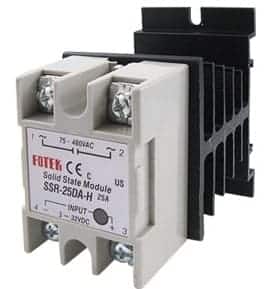Every electronics constructor and engineer knows that electronic devices like IC’s voltage regulators and CPU heat up. Temperature is a critical parameter for reliable system operation. System reliability is very closely related to devise temperature high or low. While temperature increases, the reliability drops exponentially. If you look in device datasheets, you will find a recommended Operating temperature range.

For instance, the Voltage regulator 7805 can normally operate at 0 – 70°C temperature range when maximum Junction Temperature can reach 150°C. So how is the operating temperature range calculated? It is not as difficult as it may look like. We know that temperature is analogous to voltage, thermal resistance changed to electric resistance, power dissipation is as current, then:
Temperature=Power*Thermal_Resistance;
Temperature means the rise in °C, Power in Watts, and Thermal_Resistance (°C/Watts). The calculation can be done using simple Ohms law. Let’s analyze real examples by using a simple 7805 voltage regulator. We know that output produces 5V. Let’s assume that input is 9V and output provides 1A current. Then regulators power dissipation is:
P=V·I=(9V-5V)·1A=4 Watts
So datasheet says that thermal resistance of junction to case (TO-220) is 4°C/W and case(without heat-sink) to ambient is 50°C/W. Then total thermal resistance is Rt=4+50=54°C/W. Now we can calculate the temperature rise above air surrounding temperature:
T=P· Rt =4W· 54°C/W=216°C
Well, this leads to device failure as the operating range is above 70°C. In this case, you need to add a heat sink. Then regulator and heat sink to ambient air thermal resistance is about 8°C/W. Then overall regulator thermal resistance would be Rt=4+8=12°C/W. Again calculate the temperature rise above air surrounding temperature:
T=P· Rt =4W· 12°C/W=48°C
This is a pretty critical temperature. If the ambient temperature is about 20°C, then 48°C+ 20°C=68°C is < 70°C. The working temperature is OK. But if the ambient temperature is 40°C, then the working temperature would rise to 48+40=88°C. This is a bit over from recommended. So it would be best if you considered using a better heat-sink or fan to force airflow or lower the input voltage of the voltage regulator.






T=P· Ó¨ =4W· 14°C/W=32°C is this wrong? since Ó¨=12… even 4 multiplied by 14 is wrong
Thank you for correction. That was a rude mistake in calculation, but final conclusion is ok to follow.